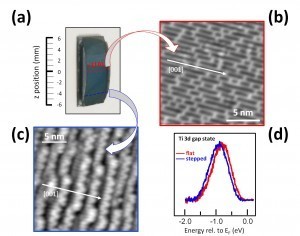INTERPLAY BETWEEN STEPS AND OXYGEN VACANCIES ON CURVED TIO2(110)
Vicinal surfaces exhibit distinct chemical and physical properties due to their high density of atomic steps, being also useful as nanoscale templates to control the growth of low dimensional structures, such as nanodots or nanostripes. In this context, a vast majority of studies on the chemistry and electronic properties of rutile r -TiO2(110) have been carried out on flat surfaces, whereas much less effort has been focused on stepped planes. Moreover, as low atomic coordination sites, the step edges are chemically and electronically very active, and hence stepped surfaces may become technologically relevant, e.g., as a way of tailoring new chemical properties of r-TiO2. Using a curved r-TiO2(110) crystal fabricated by Bihurcrystal S.L., the spin-off company of the Centro de Física de Materiales (CFM), we have performed a combined (STM-ARPES) and systematic study of stepped r-TiO2(110) with [1-10]-oriented steps.
By means of Scanning Tunneling Microscopy (STM) we analyze the structure and distribution of steps and vacancies as a function of the average deviation (miscut α) from the (110) surface, at the centre of the sample (Fig. 1 a). We observe the surface to smoothly evolve from wide terraces, containing Obr vac´s (Fig. 1 b), toward narrow (110) terraces, depleted of Obr vac´s (Fig. 1 c). We also observe the step edge morphology changing across the sample, from [1-11] zig-zag faceting to straight [1-10] steps The [1-10] steps terminate with a pair of two-fold coordinated O atoms, which give rise to bright, triangular protrusions (St). The statistical analysis of the terrace width variation across the sample allows us to detect a step-bunching phase with a large α range, triggered by an optimal d2.8 nm (110) terrace width, where all bridge-bonded O atom vacancies (Obr vac´s) vanish, but St-featured steps remain.
With Angle-Resolved Photoemission (ARPES) we focused on the Ti 3d-derived gap state (Fig. 1 d). The gap state intensity is observed to remain constant across the curved surface, directly correlating with the total density of St protrusions plus Obr vac´s measured with STM. This observation indicates that individual St protrusions (at steps) and Obr vac´s (at terraces) contribute to the crystal doping equally. The scan across the curved surface also reflects the transition from large Obr-filled terraces to the high density of St-featured steps through a 110 meV shift in apparent binding energy, which in turn suggests differences in the polaronic relaxation at terraces and steps. Density functional theory (DFT) calculations predict that St protrusions of [1-10] step edges are favorable sites for the formation of Obr vac’s in r-TiO2(110). Moreover, DFT calculations also indicate that the observed electron doping at the stepped part of the sample is not intrinsic to the step-edge, but stems from the presence of one Obr vacancy per St site.

(a) Photography of the curved TiO2(110) crystal used in the present work. Marked are the center of the crystal, with large (110) terraces and Obr vacancies [measured with STM in panel (b)], and the edge of the crystal, with a high density of steps featured with bright triangular protrusions [measured in panel (c)]. Despite the strong structural differences from flat to stepped areas of the crystal, the Ti 3d gap state peak [measured in ARPES and shown in panel (d)], shows no intensity change,, but a small 110 meV binding energy shift.



